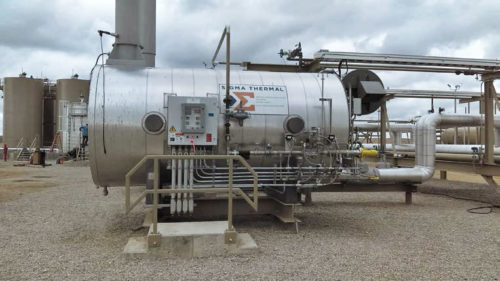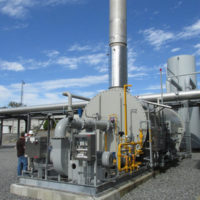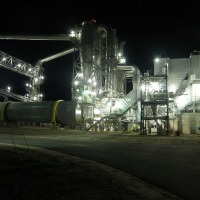Understanding Thermal Fluids & Thermal Fluid Systems
Thermal Fluid Management • Advantages of Thermal Oil Heating Systems
Types of Thermal Fluid Heaters • Work With Sigma Thermal

The demand for process heating and temperature control in the industry continues to grow as manufacturers and industrial facilities expand and strive to enhance their existing operations. These systems must operate efficiently, safely, and with minimal downtime over time.
Most industrial facilities that require distributed process systems typically choose between two main options: steam boilers or thermal fluid heating systems. Historically, boilers were the standard choice, but thermal fluid heating systems are increasingly becoming the preferred solution for many applications due to their enhanced flexibility, control, and reliability.
Â
Â
Thermal Fluid Management
Thermal fluid heating systems function within a closed-loop system where the thermal fluid (or heat transfer fluid) is constantly circulating. This continuous circulation ensures a consistent heat source that can be accessed as needed. Individual users can be controlled independently, and the thermal fluid temperature can be adjusted across different zones through secondary control loops. In most systems, the thermal fluid remains in a liquid state throughout the loop, though there are vapor-phase fluids available for specific applications that can take advantage of latent heat rather than relying solely on sensible heat.

Types of Heat Transfer Fluids
Thermal oil, water, and water-glycol solutions are commonly used in thermal fluid heating systems. Each of these heat transfer fluids has its own set of advantages and limitations depending on the operating temperature and performance requirements of the system. Understanding the characteristics of each fluid is crucial to making the right choice for each application.
- Hot water and water-glycol. Water is an excellent heat transfer medium due to its excellent thermophysical properties, but it also presents certain challenges. It can be corrosive, contains contaminants, boils at 212°F, and freezes at 32°F. Adding glycol to water increases the boiling point and lowers the freezing point, but this can slightly reduce the heat capacity.
- Thermal oil. Thermal oils can handle much higher temperatures than water-based formulas without boiling or excessively increasing system pressure. Natural oils can reach temperatures up to 600°F, while some synthetic oils allow systems to reach temperatures up to 800°F. These capabilities enable oil-based heating systems to comply with ASME Section VIII standards, resulting in long-term cost savings since systems certified under ASME Section VIII typically do not require a licensed boiler operator on-site. Thermal oils are generally non-corrosive and do not require the same level of treatment as water to prevent scaling in the system.
Â
Â
Advantages of Thermal Fluid Heating Systems

Thermal fluid heating systems, particularly thermal oil systems, offer several advantages over traditional boilers. These advantages include:
Achieving High Temperatures at Low Pressures
Thermal fluid systems provide a broader temperature range and a higher maximum temperature. These systems can reach temperatures of 0–750°F when using thermal oil, compared to steam-based systems, which can only operate up to 350°F before pressures exceed 425 PSIG. Thermal fluid systems using water-glycol solutions can also reach temperatures of 32–350°F at lower pressures than steam, offering significantly more flexibility than traditional systems.
While the temperature range is critical, the ability to operate at low pressures is equally valuable. Most hot oils operating below 600°F do not require any vapor pressure, and the maximum system pressure is only what is generated by the centrifugal circulation pumps. Even high-temperature synthetics operating as high as 750°F require less than 100 PSIG of vapor pressure. A steam system at 750°F would require over 3,200 PSIG of operating pressure.
Minimal Maintenance

Aside from regular flashpoint tests, thermal fluid heating systems require relatively little maintenance.
The circuits are simple, and the fluid does not require frequent adjustments or additions provided it is cared for and tested periodically to identify any potential issues. Additionally, thermal fluid systems do not require blowdown, re-tubing, steam trap maintenance, or water treatments like traditional boilers do.
No Attendant Needed
Due to increased safety concerns regarding boilers near workers, more industrial, state, and local regulations now require the presence of a stationary engineer in boiler rooms. Many plants across the country must maintain at least one employee with specialized training in the boiler room during active periods to monitor the boiler's operation. This is most commonly required for fire-steamed boilers.
Facilities that use thermal fluid heaters and unfired steam generators often do not need a stationary attendant. However, this advantage depends on specific state and local requirements.
Outdoor Installation
Thermal fluid systems generate indirect heating power, meaning they can be installed in remote indoor locations or outdoors. Keeping the heater and primary system components away from other key production areas helps improve overall plant safety.
Thermal fluid systems are relatively easy to install outdoors, but there are additional considerations. Cold start provisions must be taken into account when sizing a circulation pump and motor. It may also be necessary to pour slabs, weatherproof outdoor piping and equipment, and more.
Utilize Central Plant Heating
Larger or multi-purpose facilities may have high-temperature processes in conjunction with open-loop steam injection requirements. Traditionally, these facilities would need both a thermal fluid heater and a steam boiler. Today, however, these facilities can use heat exchangers and rely solely on the thermal fluid heating system instead.
Certain types of heat exchangers coupled with a readily available hot oil can produce near-instantaneous steam as thermal fluid flows into them. Operators may use this steam for sterilization, wash downs, and other processes. The advantages of a central plant heating system with a heat exchanger(s) include:
- Lower maintenance
- Fewer expenses (because there is no boiler)
- A heat system that achieves high temperatures at low-pressure levels
Â
Â
Types of Thermal Fluid Heaters

Thermal fluid heating systems are ideal for facilities that need to consistently achieve high temperatures. Oil-based systems go by many names, but they all refer to the same type of closed-loop oil-based heating system. Other common names include:
- Hot oil boiler
- Hot oil heater
- Hot oil system
- Thermal fluid heater
- Thermal fluid system
- Thermal oil boiler
- Thermal oil heater
- Thermal oil system
Notably, thermal oil-based systems are still often referred to colloquially as “boilers,†even though they do not actually boil the process fluid. For closed-loop indirect heating systems with lower process temperature requirements, hot water and water-glycol mixtures are commonly used as heat transfer fluids.
Thermal Fluid Heater Options
At Sigma Thermal, our range of systems includes the following:
-

SHOTS Electric Heater

Thermal Fluid Heater
HC-1 Thermal Fluid Systems: These systems come in horizontal, vertical up-fired, and vertical down-fired options and sizes range from 1–100 MM Btu/hr. Custom heater designs are available to meet specific project needs.
- HC-2 Thermal Fluid Systems: HC-2 systems are also available in horizontal, vertical up-fired, and vertical down-fired configurations. Sizes range from 1–100 MM Btu/hour and custom designs are available.
- SHOTS Electric Thermal Fluid System: Sigma Hot Oil Transfer Systems (SHOTS) use electrical power for circulation heaters and low-watt density immersion bundles. This creates heat without requiring fuel sources such as natural gas, fuel oil, or biomass fuel. These systems provide power in configurations from 30kW–800kW. Custom units can be constructed to provide increased power ranges from 800kW–4MW or even higher.
 Biomass Fired Thermal Fluid Heaters: These heaters achieve the same high-temperature, low-pressure heat of our most popular thermal fluid systems. Facilities can use these systems alongside other biomass energy systems to meet green energy benchmarks. Sigma Thermal provides installation, training, and equipment servicing to support these systems and help our customers meet their sustainability goals.
Biomass Fired Thermal Fluid Heaters: These heaters achieve the same high-temperature, low-pressure heat of our most popular thermal fluid systems. Facilities can use these systems alongside other biomass energy systems to meet green energy benchmarks. Sigma Thermal provides installation, training, and equipment servicing to support these systems and help our customers meet their sustainability goals.
Â
Â
Work with Sigma for Your Process Heating Needs

Sigma Thermal is a leading provider of thermal fluid heating systems, parts, and supporting services. We offer high-quality equipment that supports the energy, heating, and process needs of our customers across a broad spectrum of industries.
- Thermal fluid heating system installations
- Retrofit services
- Training
- Maintenance
- Part programs
Talk to our engineers and technicians today about your facility’s heating needs, including maintenance, parts, and full systems. Request a quote today to get your project started.
High And Low Refractive Index UV Coating Transfer Adhesive
UV Coating Transfer Adhesive,Optical Film Coating,Smartphone Back Cover Film
Ningbo Merak Advanced Materials Technology Co., Ltd. , https://www.merak-tech.com